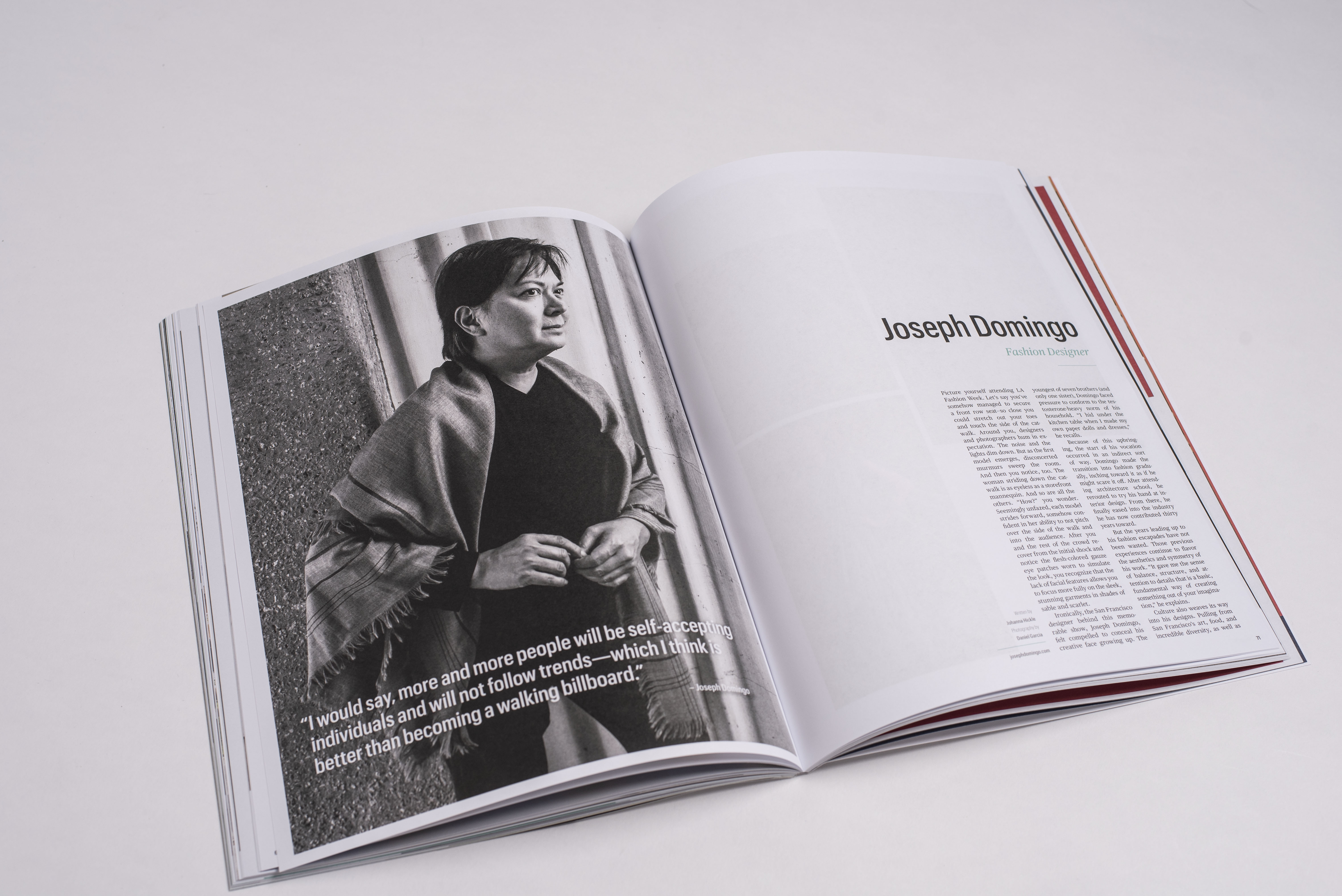Picture yourself attending LA Fashion Week. Let’s say you’ve somehow managed to secure a front row seat—so close you could stretch out your toes and touch the side of the catwalk. Around you, designers and photographers hum in expectation. The noise and the lights dim down. But as the first model emerges, disconcerted murmurs sweep the room. And then you notice, too. The woman striding down the catwalk is as eyeless as a storefront mannequin. And so are all the others. “How?” you wonder. Seemingly unfazed, each model strides forward, somehow confident in her ability to not pitch over the side of the walk and into the audience. After you and the rest of the crowd recover from the initial shock and notice the flesh-colored gauze eye patches worn to simulate the look, you recognize that the lack of facial features allows you to focus more fully on the sleek, stunning garments in shades of sable and scarlet.
Ironically, the San Francisco designer behind this memorable show, Joseph Domingo, felt compelled to conceal his creative face growing up. The youngest of seven brothers (and only one sister), Domingo faced pressure to conform to the testosterone-heavy norm of his household. “I hid under the kitchen table when I made my own paper dolls and dresses,” he recalls.
Because of this upbringing, the start of his vocation occurred in an indirect sort of way. Domingo made the transition into fashion gradually, inching toward it as if he might scare it off. After attending architecture school, he rerouted to try his hand at interior design. From there, he finally eased into the industry he has now contributed thirty years toward.

But the years leading up to his fashion escapades have not been wasted. Those previous experiences continue to flavor the aesthetics and symmetry of his work. “It gave me the sense of balance, structure, and attention to details that is a basic, fundamental way of creating something out of your imagination,” he explains.
Culture also weaves its way into his designs. Pulling from San Francisco’s art, food, and incredible diversity, as well as other countries’ museums and events, Domingo constantly integrates his surroundings into his work. “It may be a fabric, a print, a color, or a silhouette that inspires me to translate it into my own creative interpretation,” he elaborates.
Though Domingo has dabbled in ready-to-wear fashion, he’s more well-known for producing custom-made pieces out of his studio a few city blocks from Union Square. Miss American, Miss Universe, a number of Hollywood actresses, and even Shakira have adorned themselves in his handiwork. “The beauty of custom-made clothing is working with the client from start to finish,” he says, adding later, “I’m hands-on every step of the way.” There’s also the satisfaction of matching a shiny sports jacket or an asymmetric chiffon dress to the wearer’s body type. Though it may take twice the time as ready-to-wear products, Domingo notes there is something magical in the moment someone slips into an outfit crafted expressly for them.
“I would say, more and more people will be self-accepting individuals and will not follow trends—which I think is better than becoming a walking billboard.”
Besides tending to his private clients and preparing for upcoming shows, Domingo is a freelance consultant for a menswear brand in Southern California. He also partners with the fashion design program at his alma matter, West Valley College, as a producer and creative director for the graduating student fashion show and is also this year’s guest designer.
When asked what styles the fashion forward should be investing in this upcoming season, Domingo is rather cryptic. “The industry is fast and trends come and go,” he says. “I would say, more and more people will be self-accepting individuals and will not follow trends—which I think is better than becoming a walking billboard.” He certainly has come a long way from the complaisant, self-conscious little boy, driven under the family dinner table to covertly sketch dresses. Nowadays, he’d much rather stand as a walking reminder that originality, rather than conformity, will always remain in style.
Website: josephdomingo.com
This article originally appeared in Issue 11.2 “Device”


